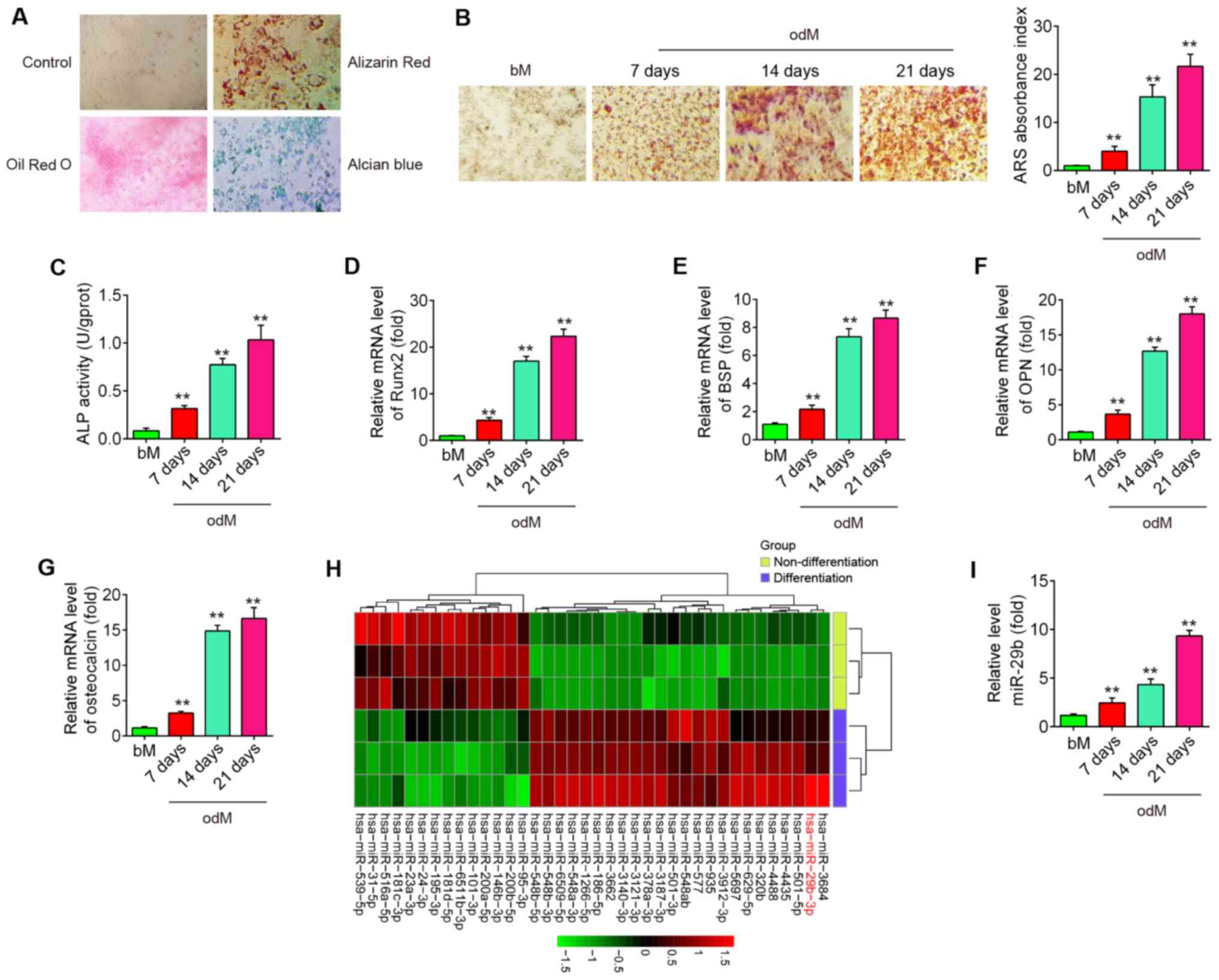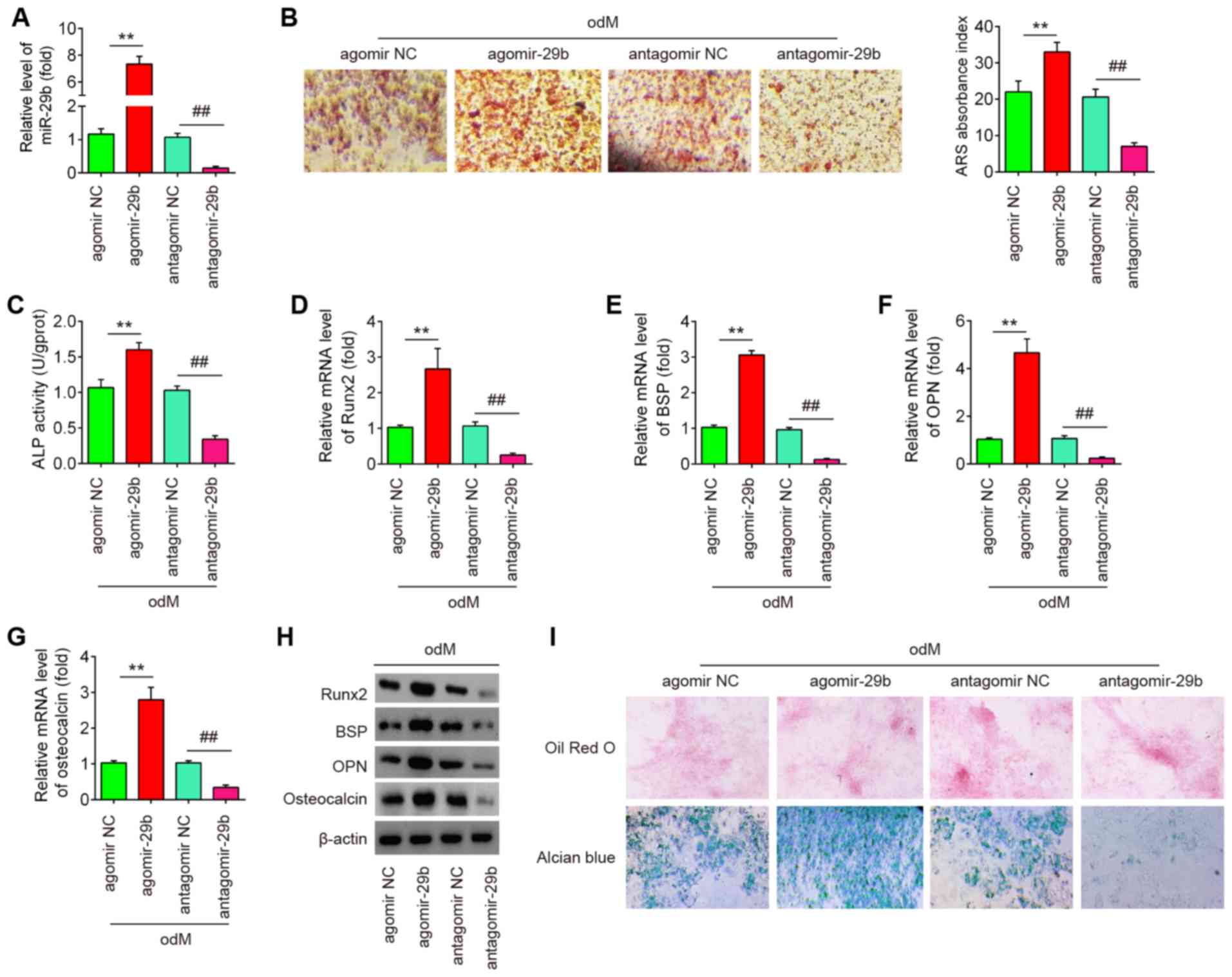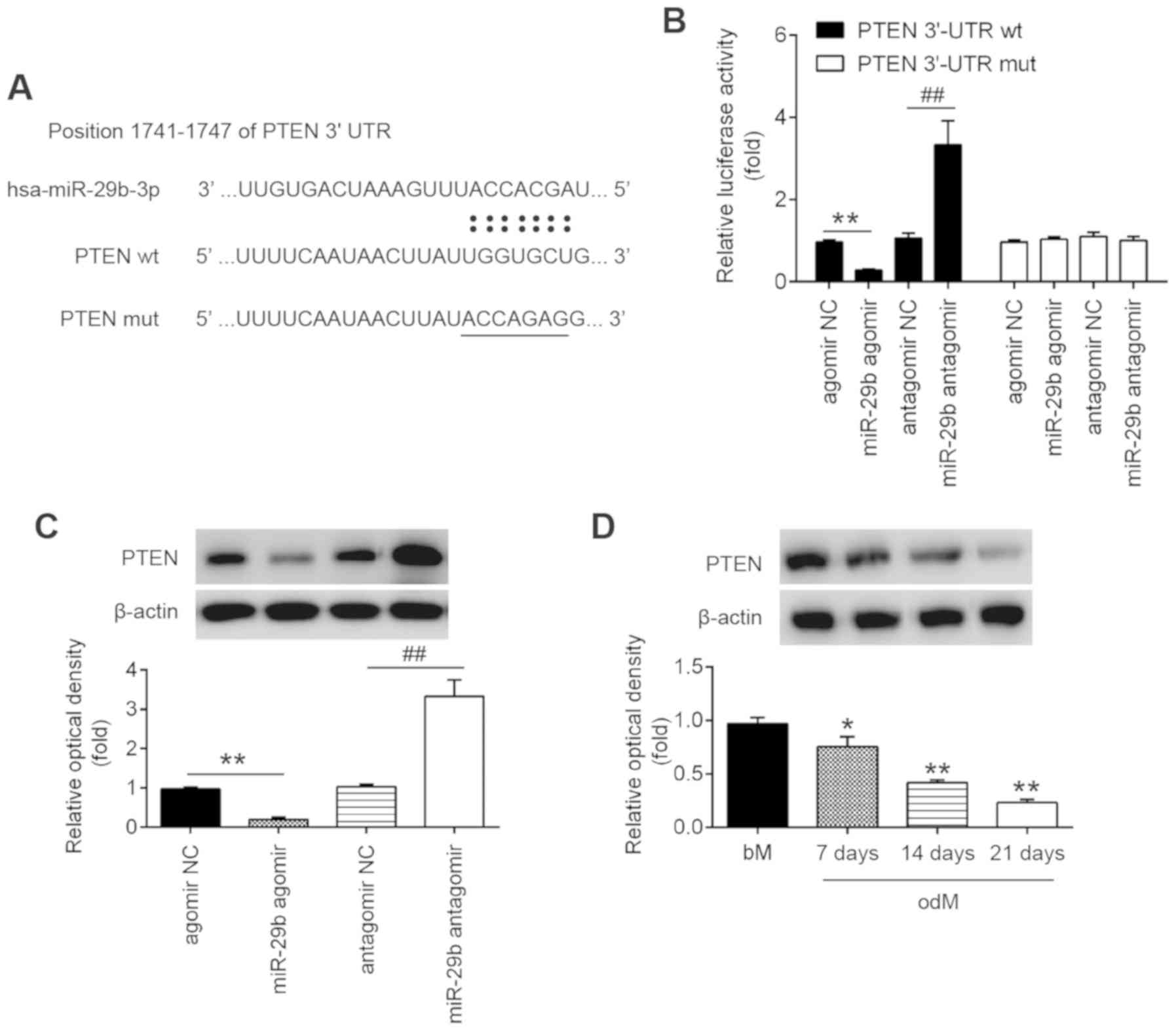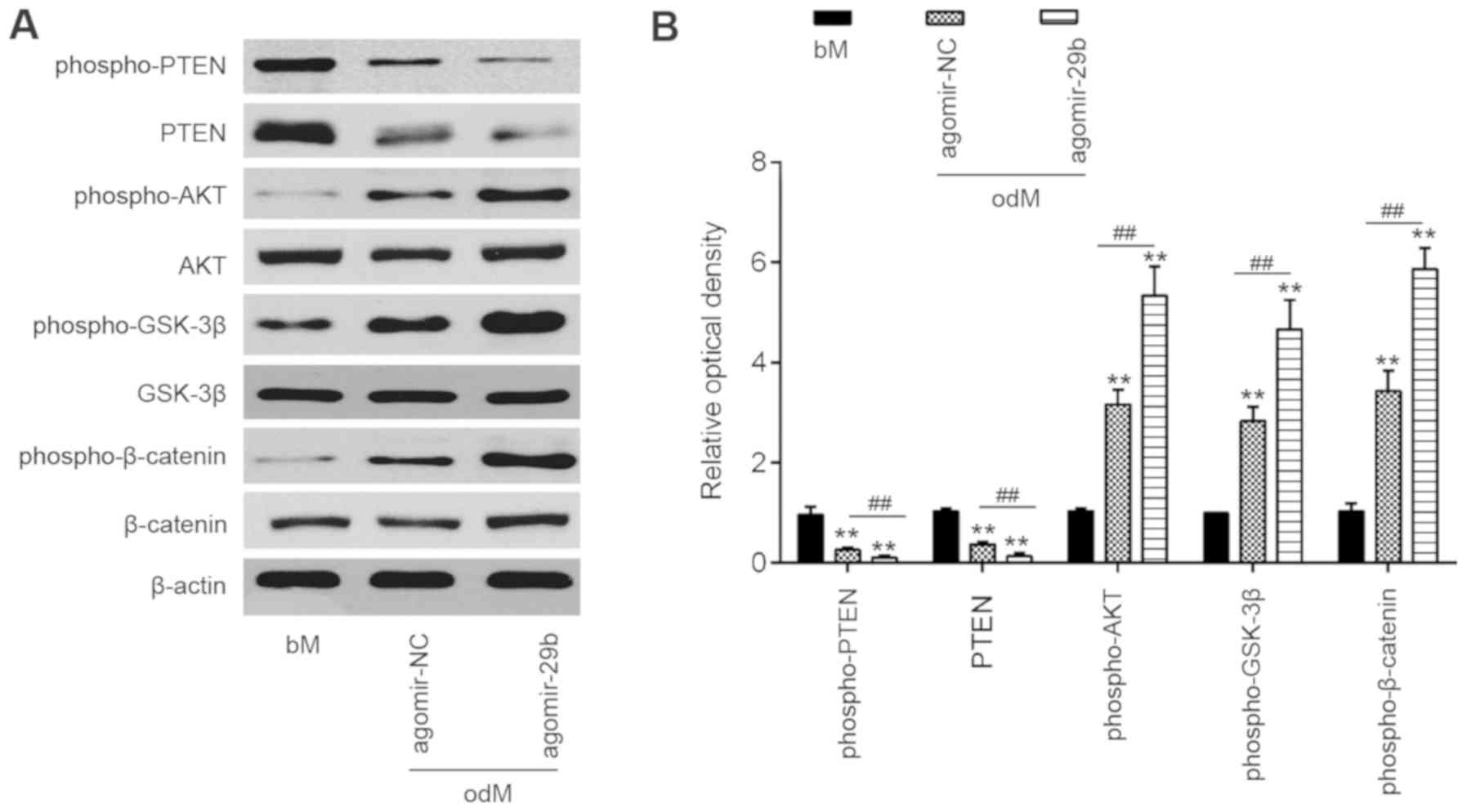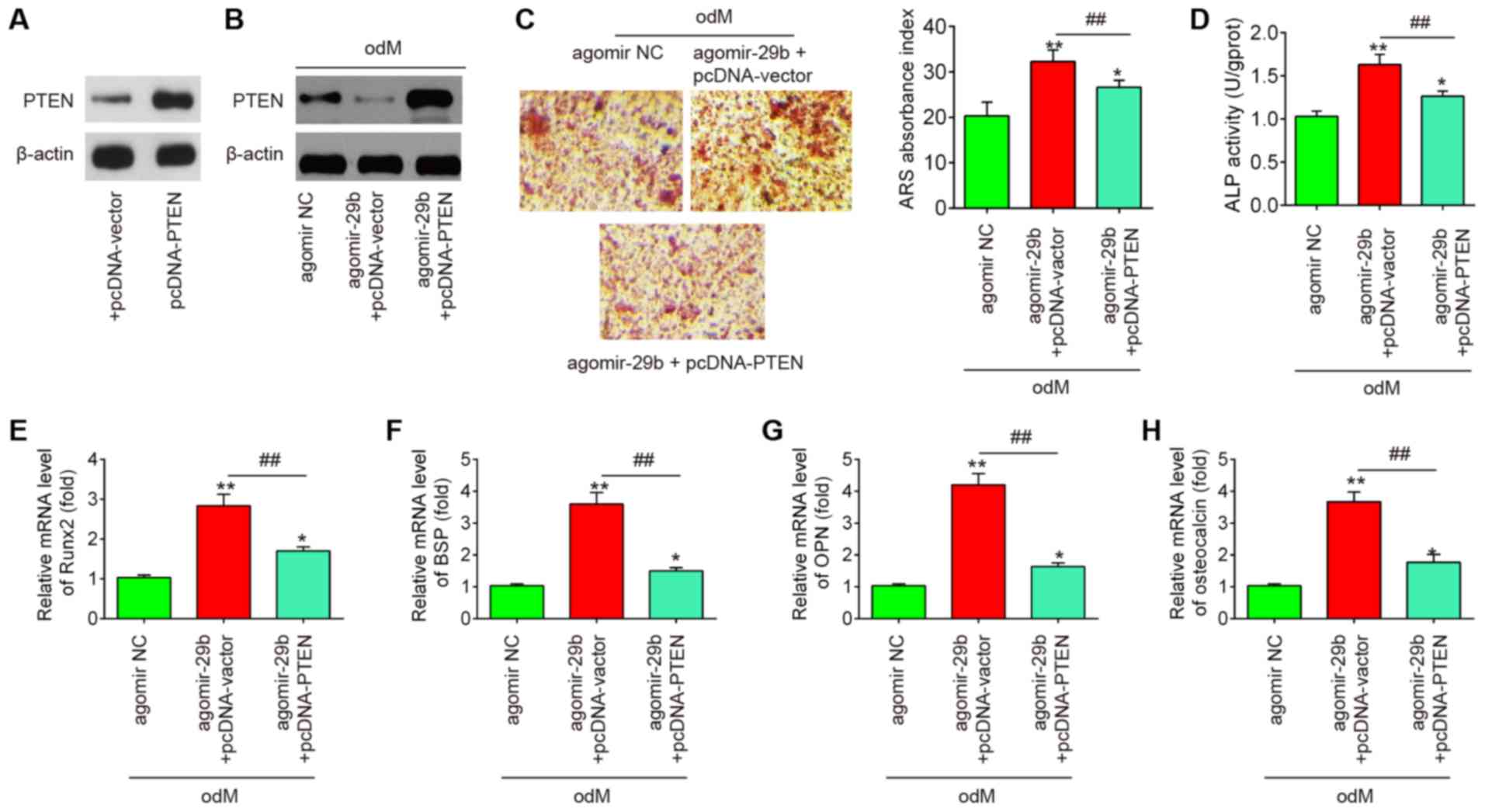|
1
|
Deng Y, Zhou H, Zou D, Xie Q, Bi X, Gu P
and Fan X: The role of miR-31-modified adipose tissue-derived stem
cells in repairing rat critical-sized calvarial defects.
Biomaterials. 34:6717–6728. 2013. View Article : Google Scholar : PubMed/NCBI
|
|
2
|
Lin CY, Chang YH, Li KC, Lu CH, Sung LY,
Yeh CL, Lin KJ, Huang SF, Yen TC and Hu YC: The use of ASCs
engineered to express BMP2 or TGF-β3 within scaffold constructs to
promote calvarial bone repair. Biomaterials. 34:9401–9412. 2013.
View Article : Google Scholar : PubMed/NCBI
|
|
3
|
Locke M, Feisst V and Dunbar PR: Concise
review: Human adipose-derived stem cells: Separating promise from
clinical need. Stem Cells. 29:404–411. 2011. View Article : Google Scholar : PubMed/NCBI
|
|
4
|
Gadkari R, Zhao L, Teklemariam T and
Hantash BM: Human embryonic stem cell derived-mesenchymal stem
cells: An alternative mesenchymal stem cell source for regenerative
medicine therapy. Regen Med. 9:453–465. 2014. View Article : Google Scholar : PubMed/NCBI
|
|
5
|
Song F, Jiang D, Wang T, Wang Y, Lou Y,
Zhang Y, Ma H and Kang Y: Mechanical stress regulates osteogenesis
and adipogenesis of rat mesenchymal stem cells through
PI3K/Akt/GSK-3β/β-catenin signaling pathway. Biomed Res Int.
2017:60274022017. View Article : Google Scholar
|
|
6
|
Wu X, Zheng S, Ye Y, Wu Y, Lin K and Su J:
Enhanced osteogenic differentiation and bone regeneration of
poly(lactic-co-glycolic acid) by graphene via activation of
PI3K/Akt/GSK-3β/β-catenin signal circuit. Biomater Sci.
6:1147–1158. 2018. View Article : Google Scholar : PubMed/NCBI
|
|
7
|
Saidak Z, Le Henaff C, Azzi S, Marty C, Da
Nascimento S, Sonnet P and Marie PJ: Wnt/β-catenin signaling
mediates osteoblast differentiation triggered by peptide-induced
α5β1 integrin priming in mesenchymal skeletal cells. J Biol Chem.
290:6903–6912. 2015. View Article : Google Scholar : PubMed/NCBI
|
|
8
|
Chen JC and Jacobs CR: Mechanically
induced osteogenic lineage commitment of stem cells. Stem Cell Res
Ther. 4:1072013. View
Article : Google Scholar : PubMed/NCBI
|
|
9
|
Ambros V: The functions of animal
microRNAs. Nature. 431:350–355. 2004. View Article : Google Scholar : PubMed/NCBI
|
|
10
|
Bartel DP: MicroRNAs: Genomics,
biogenesis, mechanism, and function. Cell. 116:281–297. 2004.
View Article : Google Scholar : PubMed/NCBI
|
|
11
|
Luzi E, Marini F, Sala SC, Tognarini I,
Galli G and Brandi ML: Osteogenic differentiation of human adipose
tissue-derived stem cells is modulated by the miR-26a targeting of
the SMAD1 transcription factor. J Bone Miner Res. 23:287–295. 2008.
View Article : Google Scholar : PubMed/NCBI
|
|
12
|
Li J, Hu C, Han L, Liu L, Jing W, Tang W,
Tian W and Long J: MiR-154-5p regulates osteogenic differentiation
of adipose-derived mesenchymal stem cells under tensile stress
through the Wnt/PCP pathway by targeting Wnt11. Bone. 78:130–141.
2015. View Article : Google Scholar : PubMed/NCBI
|
|
13
|
Kim YJ, Bae SW, Yu SS, Bae YC and Jung JS:
miR-196a regulates proliferation and osteogenic differentiation in
mesenchymal stem cells derived from human adipose tissue. J Bone
Miner Res. 24:816–825. 2009. View Article : Google Scholar
|
|
14
|
Chen S, Zheng Y, Zhang S, Jia L and Zhou
Y: Promotion effects of miR-375 on the osteogenic differentiation
of human adipose-derived mesenchymal stem cells. Stem Cell Reports.
8:773–786. 2017. View Article : Google Scholar : PubMed/NCBI
|
|
15
|
Peng S, Gao D, Gao C, Wei P, Niu M and
Shuai C: MicroRNAs regulate signaling pathways in osteogenic
differentiation of mesenchymal stem cells (Review). Mol Med Rep.
14:623–629. 2016. View Article : Google Scholar : PubMed/NCBI
|
|
16
|
Boquest AC, Shahdadfar A, Brinchmann JE
and Collas P: Isolation of stromal stem cells from human adipose
tissue. Methods Mol Biol. 325:35–46. 2006.PubMed/NCBI
|
|
17
|
Livak KJ and Schmittgen TD: Analysis of
relative gene expression data using real-time quantitative PCR and
the 2(-Delta Delta C(T)) method. Methods. 25:402–408. 2001.
View Article : Google Scholar
|
|
18
|
Mei LL, Wang WJ, Qiu YT, Xie XF, Bai J and
Shi ZZ: miR-125b-5p functions as a tumor suppressor gene partially
by regulating HMGA2 in esophageal squamous cell carcinoma. PLoS
One. 12:e01856362017. View Article : Google Scholar : PubMed/NCBI
|
|
19
|
Zhang MY, Lin J and Kui YC: MicroRNA-345
suppresses cell invasion and migration in non-small cell lung
cancer by directly targeting YAP1. Eur Rev Med Pharmacol Sci.
23:2436–2443. 2019.PubMed/NCBI
|
|
20
|
Fang S, Deng Y, Gu P and Fan X: MicroRNAs
regulate bone development and regeneration. Int J Mol Sci.
16:8227–8253. 2015. View Article : Google Scholar : PubMed/NCBI
|
|
21
|
Tang P, Xiong Q, Ge W and Zhang L: The
role of microRNAs in osteoclasts and osteoporosis. RNA Biol.
11:1355–1363. 2014. View Article : Google Scholar
|
|
22
|
Roberto VP, Tiago DM, Silva IA and Cancela
ML: MiR-29a is an enhancer of mineral deposition in bone-derived
systems. Arch Biochem Biophys. 564:173–183. 2014. View Article : Google Scholar : PubMed/NCBI
|
|
23
|
Li Z, Hassan MQ, Jafferji M, Aqeilan RI,
Garzon R, Croce CM, van Wijnen AJ, Stein JL, Stein GS and Lian JB:
Biological functions of miR-29b contribute to positive regulation
of osteoblast differentiation. J Biol Chem. 284:15676–15684. 2009.
View Article : Google Scholar : PubMed/NCBI
|
|
24
|
Mayer U, Benditz A and Grässel S: miR-29b
regulates expression of collagens I and III in chondrogenically
differentiating BMSC in an osteoarthritic environment. Sci Rep.
7:132972017. View Article : Google Scholar : PubMed/NCBI
|
|
25
|
Wang W and Cao W: Treatment of
osteoarthritis with mesenchymal stem cells. Sci China Life Sci.
57:586–595. 2014. View Article : Google Scholar : PubMed/NCBI
|
|
26
|
Baharlou R, Ahmadi-Vasmehjani A, Faraji F,
Atashzar MR, Khoubyari M, Ahi S, Erfanian S and Navabi SS: Human
adipose tissue-derived mesenchymal stem cells in rheumatoid
arthritis: Regulatory effects on peripheral blood mononuclear cells
activation. Int Immunopharmacol. 47:59–69. 2017. View Article : Google Scholar : PubMed/NCBI
|
|
27
|
Meng YB, Li X, Li ZY, Zhao J, Yuan XB, Ren
Y, Cui ZD, Liu YD and Yang XJ: microRNA-21-promotes osteogenic
differentiation of mesenchymal stem cells by the PI3K/β-catenin
pathway. J Orthop Res. 33:957–964. 2015. View Article : Google Scholar : PubMed/NCBI
|
|
28
|
Shen GY, Ren H, Huang JJ, Zhang ZD, Zhao
WH, Yu X, Shang Q, Qiu T, Zhang YZ, Tang JJ, et al: Plastrum
testudinis extracts promote BMSC proliferation and osteogenic
differentiation by regulating let-7f-5p and the TNFR2/PI3K/AKT
signaling pathway. Cell Physiol Biochem. 47:2307–2318. 2018.
View Article : Google Scholar : PubMed/NCBI
|
|
29
|
Xie Q, Wang Z, Zhou H, Yu Z, Huang Y, Sun
H, Bi X, Wang Y, Shi W, Gu P and Fan X: The role of
miR-135-modified adipose-derived mesenchymal stem cells in bone
regeneration. Biomaterials. 75:279–294. 2016. View Article : Google Scholar
|
|
30
|
Hu R, Li H, Liu W, Yang L, Tan YF and Luo
XH: Targeting miRNAs in osteoblast differentiation and bone
formation. Expert Opin Ther Targets. 14:1109–1120. 2010. View Article : Google Scholar : PubMed/NCBI
|
|
31
|
Cho HH, Shin KK, Kim YJ, Song JS, Kim JM,
Bae YC, Kim CD and Jung JS: NF-kappaB activation stimulates
osteogenic differentiation of mesenchymal stem cells derived from
human adipose tissue by increasing TAZ expression. J Cell Physiol.
223:168–177. 2010.PubMed/NCBI
|
|
32
|
Huang S, Wang S, Bian C, Yang Z, Zhou H,
Zeng Y, Li H, Han Q and Zhao RC: Upregulation of miR-22-promotes
osteogenic differentiation and inhibits adipogenic differentiation
of human adipose tissue-derived mesenchymal stem cells by
repressing HDAC 6-protein expression. Stem Cells Dev. 21:2531–2540.
2012. View Article : Google Scholar : PubMed/NCBI
|
|
33
|
Zeng Y, Qu X, Li H, Huang S, Wang S, Xu Q,
Lin R, Han Q, Li J and Zhao RC: MicroRNA-100 regulates osteogenic
differentiation of human adipose-derived mesenchymal stem cells by
targeting BMPR2. FEBS Lett. 586:2375–2381. 2012. View Article : Google Scholar : PubMed/NCBI
|
|
34
|
Wei J, Shi Y, Zheng L, Zhou B, Inose H,
Wang J, Guo XE, Grosschedl R and Karsenty G: miR-34s inhibit
osteoblast proliferation and differentiation in the mouse by
targeting SATB2. J Cell Biol. 197:509–521. 2012. View Article : Google Scholar : PubMed/NCBI
|
|
35
|
Nielsen-Preiss SM, Silva SR and Gillette
JM: Role of PTEN and Akt in the regulation of growth and apoptosis
in human osteoblastic cells. J Cell Biochem. 90:964–975. 2003.
View Article : Google Scholar : PubMed/NCBI
|
|
36
|
Zhang Y, Zhang L, Yan M and Zheng X:
Inhibition of phosphatidylinositol 3-kinase causes cell death in
rat osteoblasts through inactivation of Akt. Biomed Pharmacother.
61:277–284. 2007. View Article : Google Scholar : PubMed/NCBI
|
|
37
|
Kawamura N, Kugimiya F, Oshima Y, Ohba S,
Ikeda T, Saito T, Shinoda Y, Kawasaki Y, Ogata N, Hoshi K, et al:
Akt1 in osteoblasts and osteoclasts controls bone remodeling. PLoS
One. 2:e10582007. View Article : Google Scholar : PubMed/NCBI
|
|
38
|
Shen Y, Zhang J, Yu T and Qi C: Generation
of PTEN knockout bone marrow mesenchymal stem cell lines by
CRISPR/Cas9-mediated genome editing. Cytotechnology. 70:783–791.
2018. View Article : Google Scholar : PubMed/NCBI
|
|
39
|
Liu X, Chen T, Wu Y and Tang Z: Role and
mechanism of PTEN in adiponectin-induced osteogenesis in human bone
marrow mesenchymal stem cells. Biochem Biophys Res Commun.
483:712–717. 2017. View Article : Google Scholar
|
|
40
|
Lin X, Zhou X, Liu D, Yun L, Zhang L, Chen
X, Chai Q and Li L: MicroRNA-29 regulates high-glucose-induced
apoptosis in human retinal pigment epithelial cells through PTEN.
In. Vitro Cell Dev Biol Anim. 52:419–426. 2016. View Article : Google Scholar
|
|
41
|
Sen B, Styner M, Xie Z, Case N, Rubin CT
and Rubin J: Mechanical loading regulates NFATc1 and beta-catenin
signaling through a GSK3beta control node. J Biol Chem.
284:34607–34617. 2009. View Article : Google Scholar : PubMed/NCBI
|
|
42
|
Day TF, Guo X, Garrett-Beal L and Yang Y:
Wnt/beta-catenin signaling in mesenchymal progenitors controls
osteoblast and chondrocyte differentiation during vertebrate
skeletogenesis. Dev Cell. 8:739–750. 2005. View Article : Google Scholar : PubMed/NCBI
|
|
43
|
Qu ZH, Zhang XL, Tang TT and Dai KR:
Promotion of osteogenesis through beta-catenin signaling by
desferrioxamine. Biochem Biophys Res Commun. 370:332–337. 2008.
View Article : Google Scholar : PubMed/NCBI
|
|
44
|
Steck PA, Pershouse MA, Jasser SA, Yung
WK, Lin H, Ligon AH, Langford LA, Baumgard ML, Hattier T, Davis T,
et al: Identification of a candidate tumour suppressor gene, MMAC1,
at chromosome 10q23.3 that is mutated in multiple advanced cancers.
Nat Genet. 15:356–362. 1997. View Article : Google Scholar : PubMed/NCBI
|
|
45
|
Whang YE, Wu X, Suzuki H, Reiter RE, Tran
C, Vessella RL, Said JW, Isaacs WB and Sawyers CL: Inactivation of
the tumor suppressor PTEN/MMAC1 in advanced human prostate cancer
through loss of expression. Proc Natl Acad Sci USA. 95:5246–5250.
1998. View Article : Google Scholar : PubMed/NCBI
|















